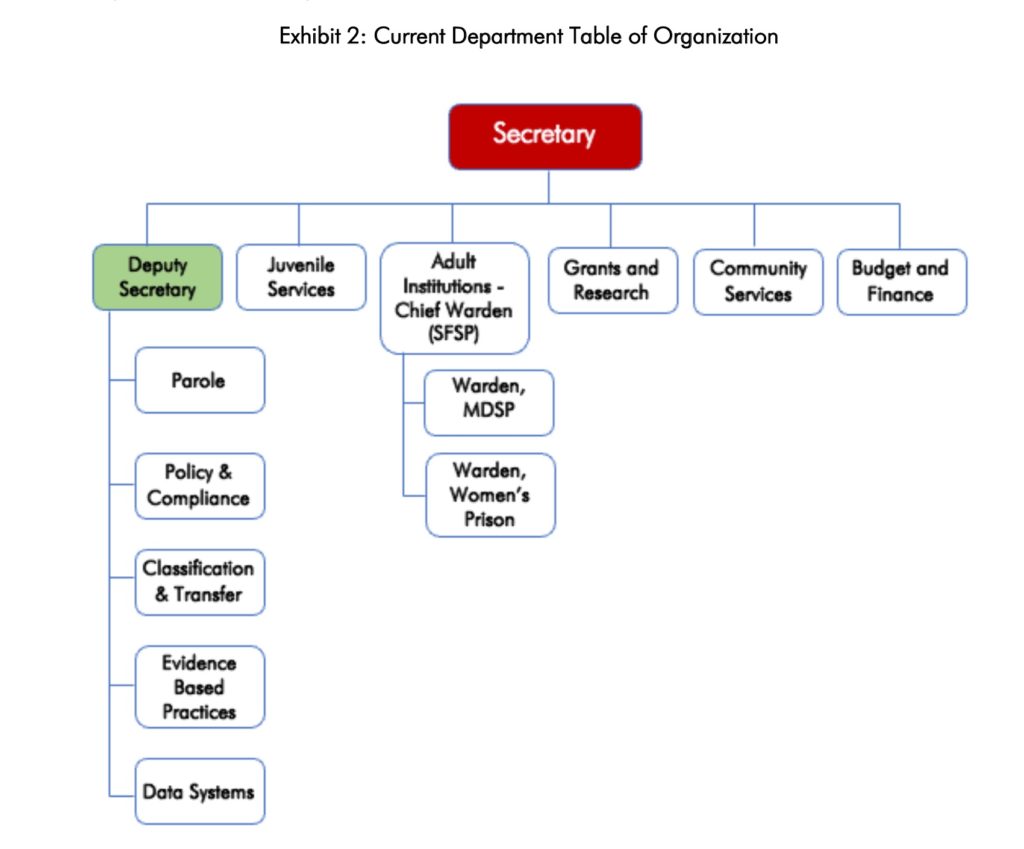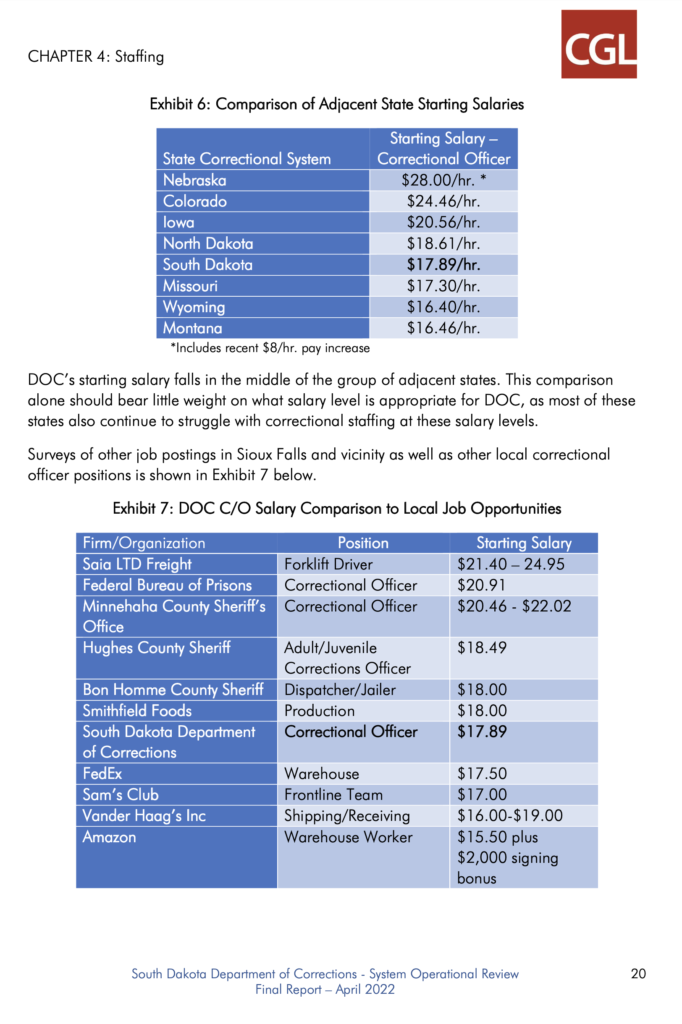CGL Companies’ review of South Dakota’s Department of Corrections, released Tuesday amidst the overwhelming storm of attention to the Ravnsborg impeachment, focuses most of its detailed recommendations on organization, staff, and facilities. Quite simply, we need to spend more money to hire and keep more staff and more administrators, and we need to build better buildings for prison staff and inmates. But the two hot issues that prompted this expensive external review, allegations of nepotism and sexual harassment, get only brief, undetailed attention and general, unprovocative recommendations.
The report, which appears to have been created April 8 by CGL senior VP Brad Sassatelli (or at least someone using his copy of Microsoft Word), says “The Department’s existing organizational structure has been described to have grown organically over time, based on the interests and capabilities of individual agency administrators.” “Grown organically” is bureaucratic code for “with no plan, study, or reason.” CGL says the current organization structure misprioritizes the functions of a modern correctional system, by putting “less pressing functions like Grants and Research and Community Services” at the top of the organization structure right alongside Adult Institutions and Juvenile Services, core functions supervising people. The structure also has those functions reporting directly to the Secretary while the Deputy Secretary is on the side assigned supervision of a mishmash of functions ranging from Parole (another important people-supervising function), Data Systems, and Evidence-Based Practices.
CGL also finds the “Chief Warden” position problematic. Currently, the warden of the State Penitentiary in Sioux Falls is also assigned as chief of the Springfield and Pierre prisons. Wardens at the Springfield and Pierre prisons report to the warden in Sioux Falls, and that warden reports directly to the Secretary. Managing the Sioux Falls prison is more than enough work for one administrator. That warden does not have time to “provide any meaningful oversight to the other facilities.” Funneling all concerns and requests from Springfield and Pierre through the Sioux Falls chief means concerns from Sioux Falls will usually get heard first
To fix those problems and others, CGL recommends reorganizing DOC from this:

…to this:

Of course, this reorganization requires creating a new position, Director of Prisons, to intermediate equally for all three wardens and the Deputy Secretary. That new administrator would have the following duties:
- Providing an annual evaluation of each warden, training director, and classification and transfer director
- Holding follow up briefings with the warden regarding each institutional audit conducted and approve each corrective action for audit non-compliance findings
- Ensuring that each facility has written emergency operations protocols and design a system where they are tested and evaluated
- Monitoring conditions of confinement and restrictive housing practices.
- Ensuring the security of facilities including assessing facility vulnerabilities.
- Ensuring pre-service training is provided for new employees and for all employees annually that is responsive to emerging issues, based on adult learning theory, and delivered by competent professionals certified by the agency as trainers
- Ensuring all facilities operate within a consistent unit management model with its underlying principle of “Being responsive to the concerns of staff and needs of inmates”.
- Providing oversight to an inmate classification system that manages inmates in the least restrictive environment necessary to maintain safe and secure facilities and the delivery of evidenced-based programs designed to reduce recidivism [CGL, April 2022, p. 12].
CGL would also expand DOC administrative staff to include on-site administrators at each facility. The three prisons have wardens, but the Community Work Centers have administrators who visit “periodically”. CGL also recommends a duty officer program that would ensure an administrator is on site at every facility on evenings and some weekend hours.
CGL says retaining staff is “the most pressing challenge” in South Dakota’s prisons. CGL finds that from April through September of last year, DOC lost two staff for every one new hire. Says CGL, “This trend of separations far outpacing new hires is not sustainable.”
CGL compares our prison guard starting pay to prison wages in nearby states (but not Minnesota, perhaps because that’s just too depressing) and to comparable local jobs:

CGL points to Nebraska’s plan to raise prison guard pay as the kind of action South Dakota will have to take to compete. (Here CGL gets $166K to tell the Governor things she could have learned for free reading this blog.) CGL says South Dakota must increase pay, try luring retired staff to come back and work, recruit area college students majoring in criminal justice, and get wardens more involved in hiring and retention to help new hires feel connected to and valued by the boss and the system. Corrections may also need to hire a recruiter and do more marketing to fill its spots.
In picky math, CGL notes that the raw vacancy rate—vacant positions divided by funded positions—understates the actual worker shortage by failing to count staff who are in training or on leave. CGL recommends that Corrections publish its functional vacancy rate rather than its raw vacancy rate to give all of us a better picture of just how bad things are.
CGL also needs a big need to enhance training. Amidst the staff shortage, training appears to be falling by the wayside. The number of Field Training Officers, who help newly hired staff expand on and apply what they learn from the training academy in their daily work, is “decreasing as there is little interest from others in accepting this responsibility” and Corrections is offering “no incentives for staff to assume the FTO role.” CGL says Corrections needs to bump the position of Training Director for the entire Department from half-time to full-time, assign FTO responsibilities to corporals to distinguish their duties from prison guards, and update training for FTOs and guards to better recognize what works with adults, women, and American Indians in particular. (Uh oh: if Governor Noem reads the line on page 32 recommending DOC “Incorporate cultural diversity training that addresses the specific cultural chracteristics of the Indigenous American population,” she’ll blow another CRT gasket!)
CGL says we need to spend big money—$608 million—on facilities as well as people. CGL finds overcrowding throughout the system, lack of staff support space, lack of program space, lack of facilities for special-needs populations, and inefficient and thus insecure layouts. The women’s prison in Pierre, for instance, is at triple capacity:
The Women’s Prison has an original design capacity of 146 inmates. At the time of our visit the facility housed 421 female inmates. The majority of the facility was triple-celled, and the gymnasium had been converted to inmate housing. The PCWC was completely triple bunked, with 6 to 9 residents crammed into small rooms or cell areas. There is little room for anything except bedding and a very minimum amount of personal property in the undersized living areas. The facility was the most crowded female correctional institution the members of the project team have ever reviewed. Until the crowding issue is remedied, management and staff are in a holding pattern attempting to manage the population. Little can be taken on in terms of changing or improving program efficacy under these conditions [CGL, April 2022, p. 15].
The overcrowding affects security by, among other things, making it hard to separate inmates of different statuses—work release, community service, community transition, parole violation—in the minimum security facilities. CGL also noticed that the prisons are not doing enough to count and lock down tools and chemicals or consistently search inmates moving from work areas to their housing. CGL makes operational recommendation in both of those areas, but the major solutions remain the hardest because they require money: building better facilities and hiring more staff.
CGL notes that its review of South Dakota’s Department of Corrections was prompted by an anonymous email alleging “sexual harassment, favoritism, nepotism, lack of proper safety equipment, low morale, inadequate pay, and reduced benefits.” CGL seems to have heard comments supporting those allegations during its review: “Staff stated that they have seen more tenured people quitting now than any other time in their work history. When asked why they thought it was occurring, they spoke of 12-hour shifts, burnout, mandatory overtime, favoritism, nepotism, retaliation, harassment, lack of empowerment, feeling unsafe, and poor communication from leadership and across departments.” However, CGL carefully frames favoritism and nepotism as matters of “perception” which DOC can “minimize” by “continuing to try to routinely check in with all staff members, communicating with staff members at all levels and across divisions, demonstrating transparency in decision making, seeking input from diverse groups of staff members, ensuring that performance is measured based on objective criteria, etc.” CGL also recommends updating the Code of Ethics to specifically prohibit favoritism and nepotism and end the ability of wardens, the director of prisons, and designees of the Secretary to grant exceptions to that code. CGL’s only recommendation with respect to sexual harassment is that “Current DOC policy, enforcement, and reporting requirements can be strengthened to address this issue, clarifying staff and management responsibilities for reporting, investigation, and enforcement.” Thus, CGL avoids specifics on two of the hottest issues that prompted last summer’s prison purge and this review and focuses instead on the big budget issues of staff and buildings.
Gosh, they could go viral and let the staff build tiny houses and the prisoners redevelop their cells with help from the entire community. The warden could go from the big boss to actively encouraging the underlings. It could be a big hit with Kristi the overseer, letting her buy her way to the vice Presidency. A positive outcome for all. Even Ian Fury could make himself loveable, maybe have a couple of episodes with Dr Oz doing the health checks. Why not?
Well…Corrections have always been an underfunded, under staffed, under educated, under qualified, take any warm body as an employee, mess. Building new walls to put our problems behind will solve nothing. As a State, we first need to find the answer to the question “What is it exactly that we want our prison system to do??”.
I am not sure how any of the following relates to a primordial system of punishment for anything.
organic (adjective)
relating to or derived from living matter:
“organic soils”
synonyms:
living · live · animate · biological · natural · biotic
antonyms:
inorganic
chemistry
relating to or denoting compounds containing carbon (other than simple binary compounds and salts) and chiefly or ultimately of biological origin. Compare with inorganic.
(of food or farming methods) produced or involving production without the use of chemical fertilizers, pesticides, or other artificial agents:
“organic farming” · “organic meat”
synonyms:
pesticide-free · additive-free · chemical-free · nonchemical · natural
physiology
relating to a bodily organ or organs.
medicine
(of a disease) affecting the structure of an organ.
denoting a relation between elements of something such that they fit together harmoniously as necessary parts of a whole:
“the organic unity of the integral work of art”
synonyms:
structured · organized · coherent · integrated · coordinated · ordered · systematic · systematized · methodical · orderly · consistent · harmonious · methodized
antonyms:
disparate
characterized by continuous or natural development:
“companies expand as much by acquisition as by organic growth”